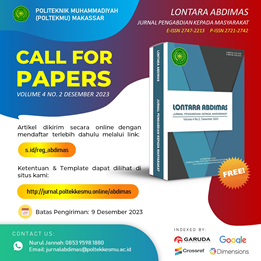Penyuluhan Penyakit Pasca Banjir Di Kelurahan Manggala Kota Makassar
Abstract
Indonesia is located on the equator with a tropical climate and has two seasons, namely the rainy season and the dry season. When entering the rainy season with high rainfall, this condition can trigger inundation and cause flooding. In addition, human activities that throw garbage in the wrong place can also exacerbate flooding. Manggala sub-district is a sub-district located east of the city of Makassar which has a lower geographical condition and a homogeneous area and is close to the final disposal site of waste so that it is most often affected by floods every year. The high flood vulnerability in the Manggala sub-district has raised concerns from various parties, one of which is the Institute for Research and Community Service of the Muhammadiyah Makassar Health Polytechnic. Through lecturers and students of the Muhammadiyah Makassar Health Polytechnic, efforts were made to prevent post-flood disease such as diarrhea and dengue fever to minimize the impact of flood risk on the community, especially in the health sector. Assistance activities carried out in the form of post-flood health education and provision of biopori pipes to reduce inundation and potential flooding if rainfall is high, this is done as a form of community service so that it can help solve health problems that exist in the community.
References
Anih Sri Suryani. (2013). Mewaspadai Potensi Penyakit Pascabanjir. Info Singkat, V(03), 3–6.
Badan Nasional Penanggulangan Bencana. (2017). Buku Saku Tanggap Tangkas Tangguh Menghadapi Bencana. Badan Nasional Penanggulangan Bencana, 62. https://siaga.bnpb.go.id/hkb/po-content/uploads/documents/Buku_Saku-10Jan18_FA.pdf
Handayani, R., & Jumiati, I. E. (2018). Dampak banjir terhadap masyarakat Desa Tegal Ratu Kecamatan Ciwandan Kota Cilegon. Pengabdian Dinamika, 5.
Rachmat, A. R. (2014). Arahan adaptasi kawasan rawan bencana banjir di Kecamatan Manggala Kota Makasar.
Santosa, S. (2018). Effect of Fruits Waste in Biopore Infiltration Hole Toward the Effectiveness of Water Infiltration Rate on Baraya Campus Land of Hasanuddin University. Journal of Physics: Conference Series, 979(1). https://doi.org/10.1088/1742-6596/979/1/012037
BPS Kota Makassar 2019. (2015). Kelurahan Manggala dalam Angka Tahun 2019. 978–979.
Sudirman, Trisutomo, S., Barkey, R. A., Ali, M., Imura, H., Onishi, A., Tsai, P., & Yonezaki, K. (2019). System of urban flood control: A Comparative Study between Kanagawa Prefecture and Makassar City. IOP Conference Series: Earth and Environmental Science, 235(1). https://doi.org/10.1088/1755-1315/235/1/012088
Thoban, M. I., & Hizbaron, D. R. (2020). Urban resilience to floods in parts of Makassar, Indonesia. E3S Web of Conferences, 200. https://doi.org/10.1051/e3sconf/202020001007
WHO. (2000). Flooding and communicable diseases fact sheet Risk assessment and preventive measures. Most, March, 1–9.











